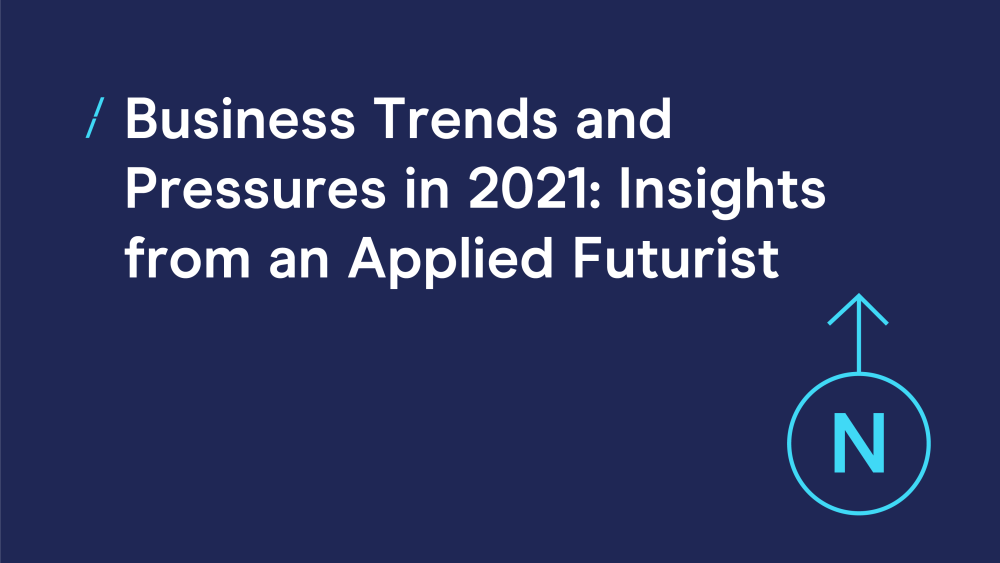Business Trends and Pressures in 2021: Insights from an Applied Futurist
14 Jan 2021

As part of DMA North's regional content, guest contributor Tom Cheesewright, Applied Futurist, tells us what business trends and pressures he expects in 2021, and why. Also a writer, speaker, broadcaster, and tech consultant, Cheesewright says “The challenge with futurism is often not seeing what will happen, but when.”
Find out what else he has to say, including his views on extended adolescence, an increase in automation, and a rise in freelance work:
Another year over and a new one just begun. Well, about to begin. What happened? And what does the new year hold?
So, now that crappy cap has been sat on the head of what has been – some notable personal high points notwithstanding – a fairly crappy year all round, what can we expect from the year ahead?
Intersections
2020 was a powerful validation of my theory of change, Intersections, which you can find in my book. This theory says that the starting point for future change can usually be found by uncovering existing pressure points. Dramatic, disruptive change tends to come from the widening of cracks that already exist, rather than completely new fissures in an enterprise, organisation, or culture. Find those cracks and understand the pressures that might widen them, and you can see what’s coming.
And so it was in 2020.
Take retail: 47% of retailers were already facing financial difficulties at the start of the year according to the Grimsey Review. Trends towards digital goods and eCommerce were already widening that crack. It was no surprise when coronavirus stuck a crowbar in that crack and cleaved the industry apart.
Or care: we knew our system was creaking. Understaffed. Underfunded. Under pressure from an ageing population. The cracks were there for all to see. They were already widening. Coronavirus just accelerated the process and brought about an early end for many as a result.
The COVID Catalyst
This is the catalysing effect that so many experts have talked of this year. It does add a layer of complexity to the Intersections model. As I’ve written before, the challenge with futurism is often not seeing what will happen, but when. Accelerants like a global pandemic can bring about years of expected change in a matter of months.
But this is why I preach agility. If you can see what’s coming but not when, your only choice is to be ready to move when it arrives.
2021 Trends and Pressures
So, what can we expect next year? In many ways, more of the same. We’ve not yet seen the full effects of the acceleration of trends on pressures in business or society. We’re clearly going into a period of financial turmoil. But what else?
These are some of the talking points I’ve been using with clients and for media interviews:
Time-Shifted Lives
I’ve been talking about extended adolescence for a while now. In the last 20 years, many of the key markers of adulthood have been pushed later and later. We now don’t learn to drive until about 27 on average. We find partners, get married, and have kids well into our 30s. Likewise with buying a home.
Thanks to coronavirus, in 2021 we’ll likely see all these things pushed back by a year, meaning that people will start their careers later, live at home longer, and have an even longer adolescence. This might be visible in the birth rate with maybe 100,000 fewer children born next year (based on some simple maths from a US study).
Robots Rise (Ahead of Schedule)
While I’ve long believed that automation presents a material risk to employment across many sectors, I’ve also believed its effects would be slower than many feared. But the pandemic has created an increased incentive for robots in a number of contexts. We may see more automation sooner rather than later.
Co-op recently increased its use of delivery drones, adding Northampton to the area covered by the Starship rolling drone. Retailers and logistics firms now have an increased incentive to shift to ‘dark warehouses,’ replacing human workers with machines.
And in the office, lots of companies are being forced to document and systematise things that used to be invisible when workers were just sat next to each other – a great opportunity to automate a lot of the drudgery of work. Lots of professional services firms, for example, are likely to stick with lower levels of staff as a result.
It doesn’t create a pretty picture for employment overall. But …
A Nation of Freelancers
In the last recession, we saw a 10% jump in those self-employed. Over the last 20 years, there has been a 50% increase in the total numbers of people working for themselves (it’s now around 15%). I think we’re going to see another big spike in 2021. A combination of people seeking work after redundancy, and people using the time they’ve gained from working at home to start a ‘side hustle’ that goes on to become their career.
Some of these new ventures might be acts of desperation. But I do think there are new markets opening up to be served. Changes to our lifestyles accelerated by the pandemic will shift our needs. Efforts to jumpstart the economy should make both space and capital available.
And with so much of our lives spent online, I think there will be a huge market for things that break us out of that digital life and give us a real, physical world experience. Everything from crafts and personalised goods to holidays and adrenalin sports.
Find out more about DMA North’s guest contributor, Tom Cheesewright, here.
Please login to comment.
Comments